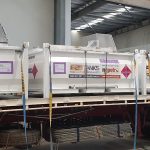Your Generator Safety Checklist
Volatile thunderstorms, heatwaves and extreme weather. Summer is here, and that means the return of wild weather and power outages in many parts of Australia.
Power outages, such as those caused by cyclones or heatwave conditions, can be catastrophic for businesses and individuals. Protecting your power supply with a portable generator is the first step you can take to prepare yourself for emergency events. A generator can help you keep your business running or get your home life back to normal quickly, open communication lines, and ensure you can perform essential tasks like pumping water and cooling food.
However, without proper maintenance, a generator won’t be helpful in an emergency. That’s why it’s so important to ensure your generator is in good working order and your fuel supply is ready to go before wild weather hits.

Below, we outline seven key points for your generator safety checklist.
1. Check your fuel containers
What condition are your fuel containers in? If you’re not sure, it’s time to check. Remove the generator from storage, drain the fuel from the tank and dispose of it properly. Inspect and clean generator fuel supply jerry cans and drum storage containers, and replace them where necessary. Inspect the fuel line for cracks and replace if necessary. Refill the tank with fresh fuel.
2. Watch Fuel Quality
Fuel tank maintenance is essential for your generator set (or genset) to run smoothly. Stagnant fuel that sits unused for months or years can encourage micro-bacterial growth, which will clog fuel lines and filters, preventing gensets from starting up in an emergency. That’s why regular fuel quality checks are so important—the sooner you can deal with this problem, the better.
Most fuel only stays fresh for about three months in ideal storage conditions, although diesel can keep for longer. If you’re using old fuel cans or don’t keep your cans full, your supply could degrade quickly and leave you in the lurch when a storm hits.
If you only use your generator in an emergency, make sure you regularly check fuel quality and take action to ensure your fuel stays fresh.
3. Treat Fuel Where Necessary
If you do find micro-bacterial growth in your fuel, it’s not the end of the world. Just as fuel test kits are available to test for micro-bacterial growth, fuel biocide treatment can treat fuel that already has this growth present.
4. Follow a Maintenance Schedule
Similar to checking fuel quality, it’s essential to follow the recommended maintenance schedule when it comes to changing fuel filters to ensure your generator will run smoothly and can access fuel supply. It’s also important to make sure your generator has enough oil. If the generator has seen heavy use, it might be time for an oil change. You can also outsource this maintenance to a trusted fuel equipment specialist to make sure everything is working correctly.
5. Check for Tank Integrity
Opting for a tank integrity testing service will go even further to ensuring the safety of your generator. This service checks to make sure all genset fuel storage tanks are tight and sealed, supply is adequate, and return lines to and from gensets are in working order.
6. Test your generator
Beyond fuel tank maintenance, it’s also important to make sure your generator is in working order. Ensure that you have a heavy duty, weatherproof extension cord that is rated for outdoor use, and that the cord isn’t damaged or worn. Plug in some appliances, like a light or a hair dryer, to make sure the generator is working properly. If you have any trouble with the generator during this test, take it to be repaired so it’s ready for when you need it.
And remember—petrol and diesel-powered generators produce deadly carbon monoxide fumes, so always run portable generators outside the house, never inside or in a garage. Keep generators away from open windows—including your neighbours’—so deadly exhaust does not enter the home.
7. Know Your Generator’s Limits
Every generator has a rated wattage that provides a limit on the appliances it can safely power. Follow the manufacturer’s recommendations for proper use and capacity and don’t try to connect lots of appliances at once. In an emergency, don’t plug your generator directly into your home’s wiring, as this can “backfeed” into power lines and cause a safety hazard.
Overloading your generator can damage the appliances it’s powering, so be sure to rotate larger items. Always read the manufacturer’s instructions carefully before plugging appliances into the generator.

Your Partner in Generator Safety
A little preparation can make all the difference during wild summer weather, keeping your business operating smoothly and helping you and your family stay safe and comfortable when power is lost.
Nqpetro are market leaders in the provision of petroleum storage solutions, and offer a number of products and services to keep your generator and fuel tanks safe, operational, and ready to run during an emergency. We also supply back-up fuel tanks and auxiliary storage units to make sure your generators are well-stocked with fuel, so you’ll always keep power running during an outage.
We currently offer fuel supply maintenance across a number of sectors, including commercial high-rise properties, government offices, airports, office blocks, residential apartments, defence bases, and retail service stations. To find out more, contact our friendly team at 07 4054 5100.





